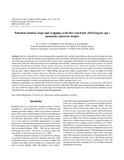| dc.description.abstract | Tomato is attacked by several plant parasitic nematodes but root-knot nematodes are the most devastating and cause
considerable losses in Kenya. Studies were undertaken under greenhouse and field conditions to determine the suppressiveness
of a wide range of plant species to root-knot (Meloidogyne spp.) nematodes. Potted plants were inoculated with 6000 eggs and
/or juveniles while the field experiments were in nematode infested fields. Among the plants tested, Tagetes patula, Gossypium
hirsutum, Desmodium uncinatum, Chloris gayana, Zea mays, Alstroemeria sp., Capsicum annuum, Crotalaria juncea,
Arachis hypogaea, Sorghum bicolor, Tithonia diversifolia and Pennisetum purpureum were rated as poor hosts with galling
and egg mass indices ranging from 0 to 3. High galling and egg mass indices ranging from 7-9 were recorded on Lablab
purpureus, Coriandum, sativum, Statice sp., Brassica oleracea var. gloria, Helianthus annuus, Vigna subterranea while
Muguna pruriens, Lactuca sativa, Allium ampeloprasum, Sesamum indicum, Allium cepa, Onnis sp., Brassica Oleracea Var.
chinensis, Asparagus sp., Brassica oleracea var. botrytis, Ornithogolum arabicum. Tuberose sp. and Chrysanthemum indicum,
were rated moderately resistant with galling and egg mass indices ranging from 3 to 6.
Damage by nematodes was significantly (P=0.05) reduced in tomato planted after sweetcorn or in sweetcorn with Tagetes
patula, Crotalaria juncea, Sorghum bicolor and Asparagus sp. in the field. This study shows that despite the fact that Meloidogyne
spp. have wide host ranges, there is a wide range of economically important plants from which suitable candidates can be
selected for use as rotation or interplants in their management. | en |

